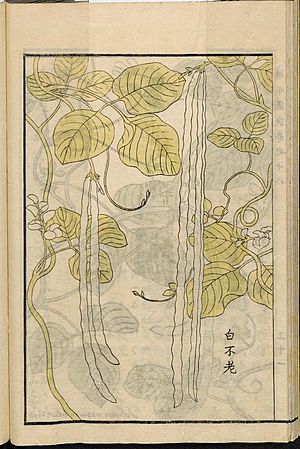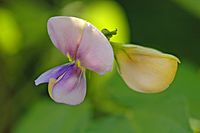Asparagus bean facts for kids
Quick facts for kids Asparagus bean |
|
|---|---|
 |
|
| Species | Vigna unguiculata (L.) Walp. |
| Cultivar group | 'sesquipedalis' |
| Cultivar | Asparagus bean |
The asparagus bean is a cool plant grown for its long, green pods. These pods have seeds inside, much like a regular green bean. You might also hear it called yardlong bean, Chinese long bean, or snake bean.
Even though it's called "yardlong," the pods are usually only about half a yard long. The plant's scientific name, sesquipedalis, means "one-and-a-half-foot-long," which is a better fit!
The asparagus bean is a type of cowpea. It's mostly grown for its really long pods, which can be 35 to 75 centimetres (1.15 to 2.46 ft) long. It's used in cooking just like green beans. This plant is different from the common bean. You can often tell different types of asparagus beans apart by the color of their seeds.
It's a strong plant that climbs like a vine and grows every year. Asparagus beans love warm, sunny places. They are grown a lot in hot parts of South Asia, Southeast Asia, and southern China.
Contents
Growing Asparagus Beans
How Asparagus Beans Grow
The pods start to grow about 60 days (2.0 months) after you plant the seeds. They hang in groups of two or more. People pick them when they are young and green to eat as a vegetable. If you miss some, and they get old, you can use the dried seeds like other dry beans.
When you pick the beans, be careful not to pick the small buds above them. These buds will grow more beans later on the same stem!
Harvesting and Care
Asparagus bean plants take a bit longer to grow than some other beans. But once they start making pods, they grow very fast. You might need to check and pick beans every day! These plants can keep producing beans until the first frost comes.
The plants are also great because they attract many pollinators, like different kinds of wasps and ants.
Where They Grow Best
Asparagus beans are easy to grow in places with hot and humid summers. Other green beans might not do well in such heat. This makes asparagus beans a good choice for these areas. They are especially easy to grow in the Southeastern United States and parts of the Midwestern United States.
How to Use Asparagus Beans
Eating Asparagus Beans
The pods are crunchy and soft. You can eat them fresh or cooked. They taste best when they are young and thin. Sometimes, people cut them into smaller pieces for cooking.
Asparagus Beans Around the World
- In the West Indies, they are often stir-fried with potatoes and shrimp.
- In Odisha, India, they are used in a sour dish called judunga besara with mustard sauce.
- They are popular in stir-fries in Chinese, Thai, and Kerala cooking.
- In the Philippines, they are stir-fried with soy sauce and garlic. They are also used in vegetable stews like pinakbet and dinengdeng.
- In Malaysian cuisine, they are often stir-fried with chillies and shrimp paste. They can also be chopped and fried in an omelette.
- In Suriname, Trinidad and Tobago, and Guyana, they are fried or curried and served with roti or rice.
Nutrition Facts
Asparagus beans are good for you! They have lots of important things your body needs.
They are a good source of:
- Protein
- Vitamin A
- Thiamin (Vitamin B1)
- Riboflavin (Vitamin B2)
- Iron
- Phosphorus
- Potassium
They are also a very good source of:
- Vitamin C
- Folate
- Magnesium
- Manganese
| Nutritional value per 100 g (3.5 oz) | |
|---|---|
| Energy | 197 kJ (47 kcal) |
|
8.35 g
|
|
|
0.4 g
|
|
|
Protein
|
2.8 g
|
| Vitamins | Quantity
%DV†
|
| Vitamin A equiv. |
5%
43 μg |
| Thiamine (B1) |
9%
0.107 mg |
| Riboflavin (B2) |
9%
0.11 mg |
| Niacin (B3) |
3%
0.41 mg |
| Vitamin B6 |
2%
0.024 mg |
| Folate (B9) |
16%
62 μg |
| Vitamin C |
23%
18.8 mg |
| Minerals | Quantity
%DV†
|
| Calcium |
5%
50 mg |
| Iron |
4%
0.47 mg |
| Magnesium |
12%
44 mg |
| Manganese |
10%
0.205 mg |
| Phosphorus |
8%
59 mg |
| Potassium |
8%
240 mg |
| Sodium |
0%
4 mg |
| Zinc |
4%
0.37 mg |
|
Link to USDA Database entry
|
|
| †Percentages estimated using US recommendations for adults. | |
A serving of 100 grams of yardlong beans has about 47 calories. It has almost no fat and only a little bit of sodium. It gives you some carbohydrates and protein too.
See also
 In Spanish: Judía de metro para niños
In Spanish: Judía de metro para niños




